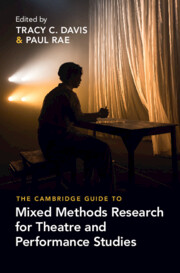Book contents
- The Cambridge Guide to Mixed Methods Research for Theatre and Performance Studies
- Reviews
- The Cambridge Guide to Mixed Methods Research for Theatre and Performance Studies
- Copyright page
- Contents
- Figures
- Tables
- Contributors
- Acknowledgements
- Introduction:
- Part I Planning
- Part II Doing
- Part III Interpreting
- Index
- References
Introduction:
Mix and Stir
Published online by Cambridge University Press: 01 February 2024
- The Cambridge Guide to Mixed Methods Research for Theatre and Performance Studies
- Reviews
- The Cambridge Guide to Mixed Methods Research for Theatre and Performance Studies
- Copyright page
- Contents
- Figures
- Tables
- Contributors
- Acknowledgements
- Introduction:
- Part I Planning
- Part II Doing
- Part III Interpreting
- Index
- References
Summary
Tracy C. Davis outlines facets of tradecraft in theatre and performance studies (TaPS). Performances based on dramatic texts or social interactions can take into account distinctions between an aesthetic focus, case studies of performance history, and extrinsic cultural factors; each kind of research prioritizes particular kinds of information and has predominant methodologies for analysis. Additionally, Davis explicates the incompleteness and unrecoverability of performances in relation to different methodologies, and the salience of theory to different methodological traditions. Ultimately, combinations are likely in order to address the complexity of TaPS research.
Information
- Type
- Chapter
- Information
- Publisher: Cambridge University PressPrint publication year: 2024
References
Accessibility standard: Unknown
Why this information is here
This section outlines the accessibility features of this content - including support for screen readers, full keyboard navigation and high-contrast display options. This may not be relevant for you.Accessibility Information
- 1
- Cited by
